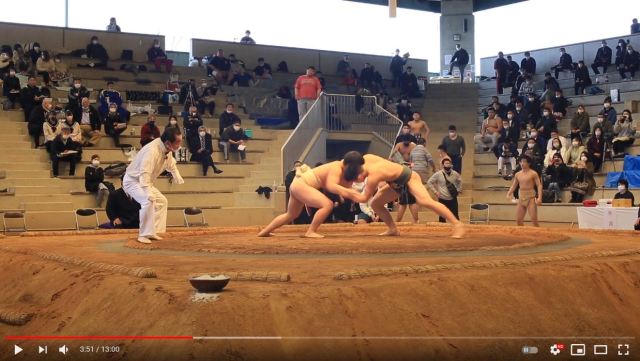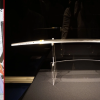
Those three words sound like a good time to me, but I guess I’m the weird one…
Japan has many traditional arts, ceremonies, and sports, and as in many other countries, these traditions often struggle to preserve their authenticity while remaining commercially viable. Sumo, however, has managed to maintain a relatively high level of interest both in Japan and abroad.
But sumo is not without its share of problems either, and the newest one to emerge is a serious threat of no future wrestlers to come up the ranks.
Like many sports, sumo wrestlers often start out on high school teams, but year on year these teams have been evaporating. According to data from the All Japan High School Athletic Federation (Kotairen), the number of high school sumo clubs has been steadily dropping from 213 in 2003 to 146 as of last year.
As a result, seven of Japan’s 47 prefectures only have one high school sumo team, giving them an automatic entry to the national championship tournament. At least it would have, had the tournament not been canceled last year due to the pandemic.
▼ The tournament hasn’t been held since 2019.
In fact, COVID-19 helped to drive down the high school sumo wrestler population even faster, with many senior students hanging up their mawashi loincloth early since there’s no tournament waiting for them at the end.
This is all bad enough, but it’s also happening against the backdrop of an overall growing disinterest in sumo among young Japanese people. This is an issue that the sumo division of Kotairen has been actively looking into over the years.
According to their research, students describe sumo as “painful-looking” and “scary,” and are hesitant to participate while wearing the highly revealing mawashi. And with organized sport options wider than ever including relatively new additions of soccer and basketball, sumo is struggling to remain attractive.
Netizens also had some ideas about why sumo isn’t resonating with kids today
“It’s because there’s no sumo wrestler that makes kids go ‘cool’ and ‘I want to be like him!'”
“Why do wrestlers have to wear those loincloths anyway? Isn’t it possible to wrestle in other clothes?”
“Swimmers are also half-naked but they aren’t complaining.”
“I think sumo is painful and scary too, but I also think baseball, soccer, and basketball are painful and scary.”
“I think the problem is that most retired sumo wrestlers just go on to open restaurants in the end.”
“I get it. I even hate going into a pool shirtless. Why can’t men get bra tops too?”
“Someone needs to make a hit manga or anime about sumo. That will get things moving again.”
“It seems like there’s a lot of bullying going on in sumo.”
“It’s just not interesting.”
Whatever the factors may be, sitting still and letting a problem run over them just isn’t the sumo way, so groups on all levels are working hard to try and entice the youth to give pushing each other around a try. One way is by setting up weight classes for under 100 kilograms (220 pounds) and under 60 kilograms (132 pounds). Previously, there were no weight divisions, meaning a tiny wrestler may have had to go toe to toe with someone over twice their size, hence the “painful” and “scary” image that sport often has.
▼ A high school match at an 80-kilogram (176 pound) limit seems to make for longer and more competitive matches
Also, during the lull in matches due to COVID-19, high school sumo wrestlers have taken the opportunity to reach out to junior high and elementary schools to turn kids on to the benefits of sumo at an early age. “If you practice more, then you can beat opponents bigger than you,” explains Masaaki Yamaoka, the captain of Okayama Prefecture’s only high school sumo team, “Even beginners can become stronger quickly.”
If anyone knows how to stand their ground and fight to the bitter end, its sumo. That being said, I think to survive, and maybe even thrive, sumo really ought to look into developing women wrestlers more. I said it back in 2014, but it bears repeating that women’s sumo kicks ass.
▼ The first International Women’s Sumo Tournament in 2013
There’re no weight classes in women’s sumo, but that doesn’t seem to phase the smaller wrestlers one bit, and they tend to come out on top about half the time against much larger opponents through highly entertaining moves and strategies. Sure, it breaks with tradition to some regard, but it breaks in a good way.
Source: The Sankei News, Hachima Kiko
Top image: YouTube/sumo archives
● Want to hear about SoraNews24’s latest articles as soon as they’re published? Follow us on Facebook and Twitter!

 High-speed Japanese sumo robots duke it out in quick and intense skirmishes 【Video】
High-speed Japanese sumo robots duke it out in quick and intense skirmishes 【Video】 Japan Sumo Association bans girls from prohibiting in practice event as controversy continues
Japan Sumo Association bans girls from prohibiting in practice event as controversy continues Japan Sumo Association surprises fans with cutesy game on Twitter
Japan Sumo Association surprises fans with cutesy game on Twitter Grand Sumo Tournament pop-up cafe pushes its way into Fukuoka
Grand Sumo Tournament pop-up cafe pushes its way into Fukuoka What’s it like to watch a sumo tournament in Tokyo during the pandemic?
What’s it like to watch a sumo tournament in Tokyo during the pandemic? Foreigner’s request for help in Tokyo makes us sad for the state of society
Foreigner’s request for help in Tokyo makes us sad for the state of society Japanese city loses residents’ personal data, which was on paper being transported on a windy day
Japanese city loses residents’ personal data, which was on paper being transported on a windy day Harajuku Station’s beautiful old wooden building is set to return, with a new complex around it
Harajuku Station’s beautiful old wooden building is set to return, with a new complex around it Red light district sushi restaurant in Tokyo shows us just how wrong we were about it
Red light district sushi restaurant in Tokyo shows us just how wrong we were about it Ghibli Park now selling “Grilled Frogs” from food cart in Valley of Witches
Ghibli Park now selling “Grilled Frogs” from food cart in Valley of Witches Akihabara pop-up shop sells goods made by Japanese prison inmates
Akihabara pop-up shop sells goods made by Japanese prison inmates Tokyo Tsukiji fish market site to be redeveloped with 50,000-seat stadium, hotel, shopping center
Tokyo Tsukiji fish market site to be redeveloped with 50,000-seat stadium, hotel, shopping center Beautiful Red and Blue Star luxury trains set to be Japan’s new Hokkaido travel stars
Beautiful Red and Blue Star luxury trains set to be Japan’s new Hokkaido travel stars Haku is…Chihiro’s dead brother? Studio Ghibli fans blown away by Spirited Away theory
Haku is…Chihiro’s dead brother? Studio Ghibli fans blown away by Spirited Away theory Real-life Rurouni Kenshin reverse-blade katana, forged by master swordsmith, now on display【Pics】
Real-life Rurouni Kenshin reverse-blade katana, forged by master swordsmith, now on display【Pics】 McDonald’s new Happy Meals offer up cute and practical Sanrio lifestyle goods
McDonald’s new Happy Meals offer up cute and practical Sanrio lifestyle goods Japanese ramen restaurants under pressure from new yen banknotes
Japanese ramen restaurants under pressure from new yen banknotes French Fries Bread in Tokyo’s Shibuya becomes a hit on social media
French Fries Bread in Tokyo’s Shibuya becomes a hit on social media Studio Ghibli releases new action figures featuring Nausicaä of the Valley of the Wind characters
Studio Ghibli releases new action figures featuring Nausicaä of the Valley of the Wind characters New private rooms on Tokaido Shinkansen change the way we travel from Tokyo to Kyoto
New private rooms on Tokaido Shinkansen change the way we travel from Tokyo to Kyoto All-you-can-drink Starbucks and amazing views part of Tokyo’s new 170 meter-high sky lounge
All-you-can-drink Starbucks and amazing views part of Tokyo’s new 170 meter-high sky lounge Beautiful Ghibli sealing wax kits let you create accessories and elegant letter decorations【Pics】
Beautiful Ghibli sealing wax kits let you create accessories and elegant letter decorations【Pics】 Studio Ghibli releases Kiki’s Delivery Service chocolate cake pouches in Japan
Studio Ghibli releases Kiki’s Delivery Service chocolate cake pouches in Japan New definition of “Japanese whiskey” goes into effect to prevent fakes from fooling overseas buyers
New definition of “Japanese whiskey” goes into effect to prevent fakes from fooling overseas buyers Our Japanese reporter visits Costco in the U.S., finds super American and very Japanese things
Our Japanese reporter visits Costco in the U.S., finds super American and very Japanese things Studio Ghibli unveils Mother’s Day gift set that captures the love in My Neighbour Totoro
Studio Ghibli unveils Mother’s Day gift set that captures the love in My Neighbour Totoro More foreign tourists than ever before in history visited Japan last month
More foreign tourists than ever before in history visited Japan last month New Pokémon cakes let you eat your way through Pikachu and all the Eevee evolutions
New Pokémon cakes let you eat your way through Pikachu and all the Eevee evolutions Sales of Japan’s most convenient train ticket/shopping payment cards suspended indefinitely
Sales of Japan’s most convenient train ticket/shopping payment cards suspended indefinitely Sold-out Studio Ghibli desktop humidifiers are back so Totoro can help you through the dry season
Sold-out Studio Ghibli desktop humidifiers are back so Totoro can help you through the dry season Japanese government to make first change to romanization spelling rules since the 1950s
Japanese government to make first change to romanization spelling rules since the 1950s Ghibli founders Toshio Suzuki and Hayao Miyazaki contribute to Japanese whisky Totoro label design
Ghibli founders Toshio Suzuki and Hayao Miyazaki contribute to Japanese whisky Totoro label design Doraemon found buried at sea as scene from 1993 anime becomes real life【Photos】
Doraemon found buried at sea as scene from 1993 anime becomes real life【Photos】 Tokyo’s most famous Starbucks is closed
Tokyo’s most famous Starbucks is closed One Piece characters’ nationalities revealed, but fans have mixed opinions
One Piece characters’ nationalities revealed, but fans have mixed opinions We asked a Uniqlo employee what four things we should buy and their suggestions didn’t disappoint
We asked a Uniqlo employee what four things we should buy and their suggestions didn’t disappoint Princesses, fruits, and blacksmiths: Study reveals the 30 most unusual family names in Japan
Princesses, fruits, and blacksmiths: Study reveals the 30 most unusual family names in Japan Japanese schoolgirls in sailor suit uniforms demonstrate 82 sumo techniques【Video】
Japanese schoolgirls in sailor suit uniforms demonstrate 82 sumo techniques【Video】 Sumo wrestlers stage group escape from dormitory over disagreements with master’s wife
Sumo wrestlers stage group escape from dormitory over disagreements with master’s wife Oddly satisfying: watching sumo wrestlers in this hand-stamp assembly line 【Video】
Oddly satisfying: watching sumo wrestlers in this hand-stamp assembly line 【Video】 Sumo wrestler vs. 16-month-old toddler: The cutest match you’ll ever see【Video】
Sumo wrestler vs. 16-month-old toddler: The cutest match you’ll ever see【Video】 Join the hordes of net users giggling at GIFs of sumo wrestlers performing comedic moves【Videos】
Join the hordes of net users giggling at GIFs of sumo wrestlers performing comedic moves【Videos】 Cats living in Tokyo sumo training facility are champions of cuteness 【Photos】
Cats living in Tokyo sumo training facility are champions of cuteness 【Photos】 Nike commercial about gender inequality in Japan receives backlash online【Video】
Nike commercial about gender inequality in Japan receives backlash online【Video】 Adorable sumo egg cups are here to turn your breakfast table into a wrestling ring
Adorable sumo egg cups are here to turn your breakfast table into a wrestling ring Congratulations on being awesome at sumo! Have a giant macaron!
Congratulations on being awesome at sumo! Have a giant macaron! Google Maps captures “only in Japan” moment as sumo wrestler sneaks a peek at Google car
Google Maps captures “only in Japan” moment as sumo wrestler sneaks a peek at Google car Four things women are banned from doing in Japan【Women in Japan Series】
Four things women are banned from doing in Japan【Women in Japan Series】 Sumo horse racing game returns with guest appearances from Street Fighter characters!
Sumo horse racing game returns with guest appearances from Street Fighter characters! What the heck is this huge sumo wrestler doing at Ryogoku Station in Tokyo?
What the heck is this huge sumo wrestler doing at Ryogoku Station in Tokyo? Meet Chiyomaru: the cutest gosh-darn sumo wrestler you’ll ever see
Meet Chiyomaru: the cutest gosh-darn sumo wrestler you’ll ever see
Leave a Reply